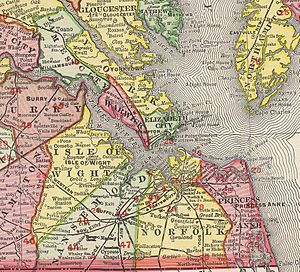Nansemond County, Virginia facts for kids
Nansemond was an area in Virginia that existed from 1646 to 1974. It was first called Nansemond County until 1972. For about 18 months, from 1972 to 1974, it was known as the independent city of Nansemond. Today, this area is part of the city of Suffolk.
English settlers named Nansemond after the Nansemond people. They are a tribe of Native Americans who lived along the Nansemond River. This river flows into the James River. The Nansemond people met English colonists when they arrived in 1607 at Jamestown. Even though they faced many challenges, the Nansemond Indian Nation is still active in Virginia today. They gained official recognition from the state in 1985 and from the federal government in 2018.
Contents
History of Nansemond
Early Beginnings (1600s)
In 1619, the area that became Nansemond County was part of a large region called Elizabeth Cittie. This was during the time of the Virginia Company of London. In 1624, the Virginia Company lost its special permission to run the colony. Virginia then became a royal colony, meaning it was directly controlled by the King of England.
In 1634, the King created eight large areas called "shires" or "counties" in the colony. One of these was Elizabeth River Shire. Two years later, in 1636, New Norfolk County was formed from Elizabeth River Shire. This new county included all the land in what is now South Hampton Roads. In 1637, New Norfolk County was split into two parts: Upper Norfolk County and Lower Norfolk County.
Upper Norfolk County was officially renamed the County of Nansimum in March 1646. This name was also spelled Nansimund. The English named it after the native Nansemond people. These people lived along the Nansemond River. The Nansemond are still a federally recognized tribe today.
Growth and Change (1700s)
In the 1720s, a man named John Constant settled along the Nansemond River. He built a home, a dock, and a warehouse. This place became known as "Constant's Warehouse."
Tobacco was a very important crop in the Virginia colony. There was a high demand for it in England and Europe. In 1730, a law called the Tobacco Inspection Act was passed. This law set up places to inspect tobacco. Three of these inspection warehouses were in Nansemond County.
In 1742, the Virginia House of Burgesses created a new town at Constant's Wharf. They renamed it Suffolk.
In 1750, the main government center, or county seat, of Nansemond County moved to Suffolk. Suffolk was founded in 1742 at Constant's Warehouse. It was named after the English hometown of the Royal Governor, William Gooch.
Becoming Independent (1800s)
Suffolk became an official town in 1808. Later, in 1910, it became an independent city. This meant it was no longer part of Nansemond County. However, Suffolk still remained the county seat for Nansemond County. Suffolk and Nansemond County also shared a court system and other government officials.
Modern Mergers (1900s)
Between 1952 and 1976, many areas in southeastern Virginia combined. As part of this trend, Nansemond County merged with two nearby towns, Holland and Whaleyville. This created the independent city of Nansemond.
Just two years later, the city of Nansemond merged with Suffolk. This formed the present-day independent city of Suffolk. The new city covers about 430 square miles (1,114 square kilometers). This makes it the largest city in Hampton Roads by land area. It is also one of the largest cities in Virginia and the United States by land area. The independent city of Nansemond only existed for 18 months, making it the shortest-lived independent city in Virginia's history.


